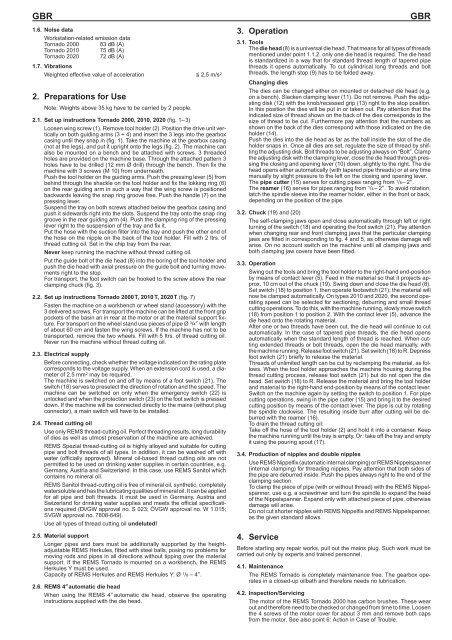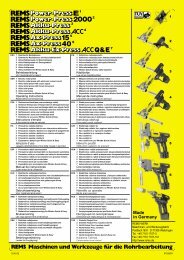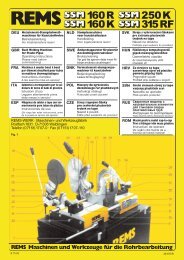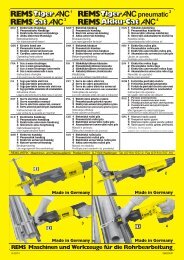Maschinen und Werkzeuge für die Rohrbearbeitung
Maschinen und Werkzeuge für die Rohrbearbeitung
Maschinen und Werkzeuge für die Rohrbearbeitung
You also want an ePaper? Increase the reach of your titles
YUMPU automatically turns print PDFs into web optimized ePapers that Google loves.
GBR GBR<br />
1.6. Noise data<br />
Workstation-related emission data<br />
Tornado 2000 83 dB (A)<br />
Tornado 2010 75 dB (A)<br />
Tornado 2020 72 dB (A)<br />
1.7. Vibrations<br />
Weighted effective value of acceleration 2,5 m/s2 2. Preparations for Use<br />
Note: Weights above 35 kg have to be carried by 2 people.<br />
2.1. Set up instructions Tornado 2000, 2010, 2020 (fig. 1–3)<br />
Loosen wing screw (1). Remove tool holder (2). Position the drive unit vertically<br />
on both guiding arms (3 + 4) and insert the 3 legs into the gearbox<br />
casing until they snap in (fig. 1). Take the machine at the gearbox casing<br />
(not at the legs), and put it upright onto the legs (fig. 2). The machine can<br />
also be mounted on a bench and be attached with screws. 3 threaded<br />
holes are provided on the machine base. Through the attached pattern 3<br />
holes have to be drilled (12 mm Ø drill) through the bench. Then fix the<br />
machine with 3 screws (M 10) from <strong>und</strong>erneath.<br />
Push the tool holder on the guiding arms. Push the pressing lever (5) from<br />
behind through the shackle on the tool holder and fix the lokking ring (6)<br />
on the rear guiding arm in such a way that the wing screw is positioned<br />
backwards leaving the snap ring groove free. Push the handle (7) on the<br />
pressing lever.<br />
Suspend the tray on both screws attached below the gearbox casing and<br />
push it sidewards right into the slots. Suspend the tray onto the snap ring<br />
groove in the rear guiding arm (4). Push the clamping ring of the pressing<br />
lever right to the suspension of the tray and fix it.<br />
Put the hose with the suction filter into the tray and push the other end of<br />
the hose on the nipple on the back of the tool holder. Fill with 2 ltrs. of<br />
thread cutting oil. Set in the chip tray from the rear.<br />
Never keep running the machine without thread cutting oil.<br />
Put the guide bolt of the <strong>die</strong> head (8) into the boring of the tool holder and<br />
push the <strong>die</strong> head with axial pressure on the guide bolt and turning movements<br />
right to the stop.<br />
For transport, the foot switch can be hooked to the screw above the rear<br />
clamping chuck (fig. 3).<br />
2.2. Set up instructions Tornado 2000T, 2010 T, 2020T (fig. 7)<br />
Fasten the machine on a workbench or wheel stand (accessory) with the<br />
3 delivered screws. For transport the machine can be lifted at the front grip<br />
pockets of the basin an in rear at the motor or at the material support fixture.<br />
For transport on the wheel stand use pieces of pipe Ø 3 /4” with length<br />
of about 60 cm and fasten the wing screws. If the machine has not to be<br />
transported, remove the two wheels. Fill with 5 Itrs. of thread cutting oil.<br />
Never run the machine without thread cutting oil.<br />
2.3. Electrical supply<br />
Before connecting, check whether the voltage indicated on the rating plate<br />
corresponds to the voltage supply. When an extension cord is used, a diameter<br />
of 2.5 mm2 may be required.<br />
The machine is switched on and off by means of a foot switch (21). The<br />
switch (18) serves to preselect the direction of rotation and the speed. The<br />
machine can be switched on only when the emergency switch (22) is<br />
unlocked and when the protection switch (23) on the foot switch is pressed<br />
down. If the machine will be connected directly to the mains (without plug<br />
connector), a main switch will have to be installed.<br />
2.4. Thread cutting oil<br />
Use only REMS thread-cutting oil. Perfect threading results, long durability<br />
of <strong>die</strong>s as well as utmost preservation of the machine are achieved.<br />
REMS Spezial thread-cutting oil is highly alloyed and suitable for cutting<br />
pipe and bolt threads of all types. In addition, it can be washed off with<br />
water (officially approved). Mineral oil-based thread cutting oils are not<br />
permitted to be used on drinking water supplies in certain countries, e.g.<br />
Germany, Austria and Switzerland. In this case, use REMS Sanitol which<br />
contains no mineral oil.<br />
REMS Sanitol thread-cutting oil is free of mineral oil, synthetic, completely<br />
watersoluble and has the lubricating qualities of mineral oil. It can be applied<br />
for all pipe and bolt threads. It must be used in Germany, Austria and<br />
Swizerland for drinking water supplies and meets the official specifications<br />
required (DVGW approval no. S 023; ÖVGW approval no. W 1.015;<br />
SVGW approval no. 7808-649).<br />
Use all types of thread cutting oil <strong>und</strong>eluted!<br />
2.5. Material support<br />
Longer pipes and bars must be additionally supported by the heightadjustable<br />
REMS Herkules, fitted with steel balls, posing no problems for<br />
moving rods and pipes in all directions without tipping over the material<br />
support. If the REMS Tornado is mounted on a workbench, the REMS<br />
Herkules Y must be used.<br />
Capacity of REMS Herkules and REMS Herkules Y: Ø 1 /8 – 4”.<br />
2.6. REMS 4”automatic <strong>die</strong> head<br />
When using the REMS 4”automatic <strong>die</strong> head, observe the operating<br />
instructions supplied with the <strong>die</strong> head.<br />
3. Operation<br />
3.1. Tools<br />
The <strong>die</strong> head (8) is a universal <strong>die</strong> head. That means for all types of threads<br />
mentioned <strong>und</strong>er point 1.1.2. only one <strong>die</strong> head is required. The <strong>die</strong> head<br />
is standardized in a way that for standard thread length of tapered pipe<br />
threads it opens automatically. To cut cylindrical long threads and bolt<br />
threads, the length stop (9) has to be folded away.<br />
Changing <strong>die</strong>s<br />
The <strong>die</strong>s can be changed either on mounted or detached <strong>die</strong> head (e.g.<br />
on a bench). Slacken clamping lever (11). Do not remove. Push the adjusting<br />
disk (12) with the knob/recessed grip (13) right to the stop position.<br />
In this position the <strong>die</strong>s will be put in or taken out. Pay attention that the<br />
indicated size of thread shown on the back of the <strong>die</strong>s corresponds to the<br />
size of thread to be cut. Furthermore pay attention that the numbers as<br />
shown on the back of the <strong>die</strong>s correspond with those indicated on the <strong>die</strong><br />
holder (14).<br />
Push the <strong>die</strong>s into the <strong>die</strong> head as far as the ball inside the slot of the <strong>die</strong><br />
holder snaps in. Once all <strong>die</strong>s are set, regulate the size of thread by shifting<br />
the adjusting disk. Bolt threads to be adjusting always on “Bolt”. Clamp<br />
the adjusting disk with the clamping lever, close the <strong>die</strong> head through pressing<br />
the closing and opening lever (10) down, slightly to the right. The <strong>die</strong><br />
head opens either automatically (with tapered pipe threads) or at any time<br />
manually by slight pressure to the left on the closing and opening lever.<br />
The pipe cutter (15) serves for cutting pipes ranging from 1 /8–2”.<br />
The reamer (16) serves for pipes ranging from 1 /4–2”. To avoid rotation,<br />
latch the spindle sleeve into the reamer holder, either in the front or back,<br />
depending on the position of the pipe.<br />
3.2. Chuck (19) and (20)<br />
The self-clamping jaws open and close automatically through left or right<br />
turning of the switch (18) and operating the foot switch (21). Pay attention<br />
when changing rear and front clamping jaws that the particular clamping<br />
jaws are fitted in corresponding to fig. 4 and 5, as otherwise damage will<br />
arise. On no account switch on the machine until all clamping jaws and<br />
both clamping jaw covers have been fitted.<br />
3.3. Operation<br />
Swing out the tools and bring the tool holder to the right-hand end-position<br />
by means of contact lever (5). Feed in the material so that it projects approx.<br />
10 cm out of the chuck (19). Swing down and close the <strong>die</strong> head (8).<br />
Set switch (18) to position 1, then operate footswitch (21); the material will<br />
now be clamped automatically. On types 2010 and 2020, the second operating<br />
speed can be selected for sectioning, deburring and small thread<br />
cutting operations. To do this, with the machine running, slowly move switch<br />
(18) from position 1 to position 2. With the contact lever (5), advance the<br />
<strong>die</strong> head onto the rotating material.<br />
After one or two threads have been cut, the <strong>die</strong> head will continue to cut<br />
automatically. In the case of tapered pipe threads, the <strong>die</strong> head opens<br />
automatically when the standard length of thread is reached. When cutting<br />
extended threads or bolt threads, open the <strong>die</strong> head manually, with<br />
the machine running. Release foot switch (21). Set switch (18) to R. Depress<br />
foot switch (21) briefly to release the material.<br />
Threads of unlimited length can be cut by reclamping the material, as follows.<br />
When the tool holder approaches the machine housing during the<br />
thread cutting process, release foot switch (21) but do not open the <strong>die</strong><br />
head. Set switch (18) to R. Release the material and bring the tool holder<br />
and material to the right-hand end-position by means of the contact lever.<br />
Switch on the machine again by setting the switch to position 1. For pipe<br />
cutting operations, swing in the pipe cutter (15) and bring it to the desired<br />
cutting position by means of the contact lever. The pipe is cut by rotating<br />
the spindle clockwise. The resulting inside burr after cutting will be deburred<br />
with the reamer (16).<br />
To drain the thread cutting oil:<br />
Take off the hose of the tool holder (2) and hold it into a container. Keep<br />
the machine running until the tray is empty. Or: take off the tray and empty<br />
it using the pouring spout (17).<br />
3.4. Production of nipples and double nipples<br />
Use REMS Nippelfix (automatic internal clamping) or REMS Nippelspanner<br />
(internal clamping) for threading nipples. Pay attention that both sides of<br />
the pipe are deburred inside. Push the pipes always right to the end of the<br />
clamping section.<br />
To clamp the piece of pipe (with or without thread) with the REMS Nippelspanner,<br />
use e.g. a screwdriver and turn the spindle to expand the head<br />
of the Nippelspanner. Expand only with attached piece of pipe, otherwise<br />
damage will arise.<br />
Do not cut shorter nipples with REMS Nippelfix and REMS Nippelspanner,<br />
as the given standard allows.<br />
4. Service<br />
Before starting any repair works, pull out the mains plug. Such work must be<br />
carried out only by experts and trained personnel.<br />
4.1. Maintenance<br />
The REMS Tornado is completely maintenance free. The gearbox operates<br />
in a closed-up oilbath and therefore needs no lubrication.<br />
4.2. Inspection/Servicing<br />
The motor of the REMS Tornado 2000 has carbon brushes. These wear<br />
out and therefore need to be checked or changed from time to time. Loosen<br />
the 4 screws of the motor cover for about 3 mm and remove both caps<br />
from the motor. See also point 6: Action in Case of Trouble.






